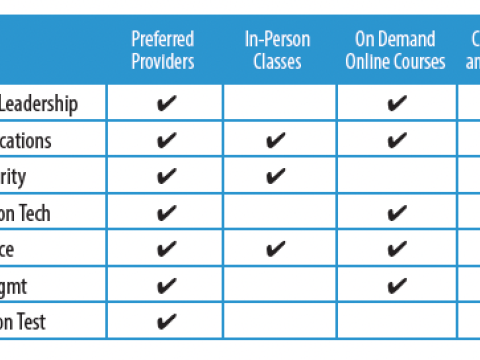Part Inspiration, Part Determination
I was walking our two dogs listening to a “Stuff Mom Never Told You” podcast when the women in STEM idea piqued my interest. The topic intrigued me mostly because I thought in 2016 the issue of gender in the workplace had been settled. In a way, I was right. Career options for women were no longer limited to teaching, nursing or the nunnery.
Those appeared to be my only options as a girl growing up on Chicago’s Southside in the late 19…well, let’s just say when I was starting my career as a journalist, the Equal Rights Amendment was making its way around the states for ratification. But as my career progressed, I saw more females in a variety of professional positions. So, a discussion about a dearth of women in the science, technology, engineering and math (STEM) fields caught me by surprise.
Fortunately, I work at AFCEA, where promoting STEM education is of paramount importance. Bringing the topic to the attention to the membership team was all I had to do to get the ball rolling not only on investigating the topic but also doing something about it.
With the whole-hearted support of AFCEA’s President and CEO Lt. Gen. Bob Shea, USMC (Ret.), the idea snowballed from hosting the first all-female panel focusing on women in STEM at TechNet Augusta 2016 to a 10-part series on the SIGNAL website. Based on interviews with successful women in STEM professions, the articles took a closer look at how female military and industry leaders entered and then stuck with jobs that still are largely male dominated.
Others agreed that this was an important topic. The SIGNAL series recently won an APEX Award for Excellence, and what these women said about how they got to where they are illustrates their own determination and some insights into the work that must continue.
While reviewing the series, certain themes emerged. The most surprising was that all these women knew in their hearts that they were destined to work in STEM fields. Several, including Mylene Frances Lee and Maj. Gen. Sandra, Finan, USAF, started out in different fields, but technology called to them, and they chose to follow. Many were one of only a handful of women in their courses. They didn’t let it stop them.
Gen. Ellen M. Pawlikowski, USAF, who commands the U.S. Air Force Materiel Command at Wright-Patterson Air Force Base, described her initiation into a male-dominated field. She said she never felt she didn’t belong in the STEM community, even when, as a freshman at the New Jersey Institute of Technology (NJIT), her physics professor started every class with, “Gentlemen, this is what we will cover today.”
But it takes more than intuition and willpower to succeed in STEM fields today. These women look at the STEM work force and see the need to rethink the very institutions they experienced. Education is key, many said, and the nitty-gritty elements of science and technology must be introduced at the elementary school level. "There is this lost generation that didn't get STEM early enough," said Evetta-DiRee McGuire, a senior program manager at ManTech International Corporation.
Mentorship also is crucial both to encouraging women to enter technical fields and stay in them. Nearly all the interviewees had at least one senior adviser who wouldn’t let them give up. Today, all of them are doing the same for the female newbies in the field.
Although these women spoke about how STEM careers benefited them, one fascinating twist was their belief that closing the gender gap is important to the United States. Time and again they emphasized how addressing what is largely thought to be a societal issue is so much more.
Gen. Pawlikowski explained it this way: “Everywhere I go, I try to provide an environment that nurtures all kinds of diversity. Particularly in science and engineering, the diversity of thought that comes from having people from many different walks of life, from many different backgrounds, is a tremendous multiplier when it comes to problem solving.”
Rear Adm. Nancy Norton, USN, director of warfare integration and deputy director for Navy cybersecurity, agreed. “I don't want 100 people with one idea. I want 100 people with 100 ideas, and then we can figure out what the best ones are.”
Since that dog walk last year, I’ve had at least 100 ideas, some better than others. Bringing attention to supporting women in STEM was one of the better ones.
Has the gender gap shrunk since the 1970s? A bit. Be sure to read One Small Step Taken. One Giant Leap Needed. for a millennial perspective of this issue.
For the second year, TechNet Augusta will feature an all-women panel. Join the discussion at the Women in Cyber session at 1:30 p.m. on August 9.





Comments